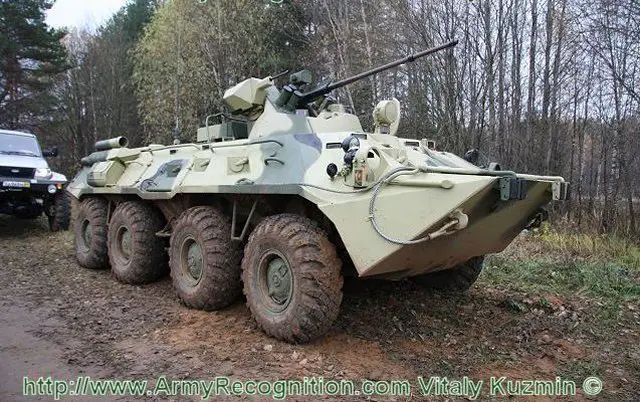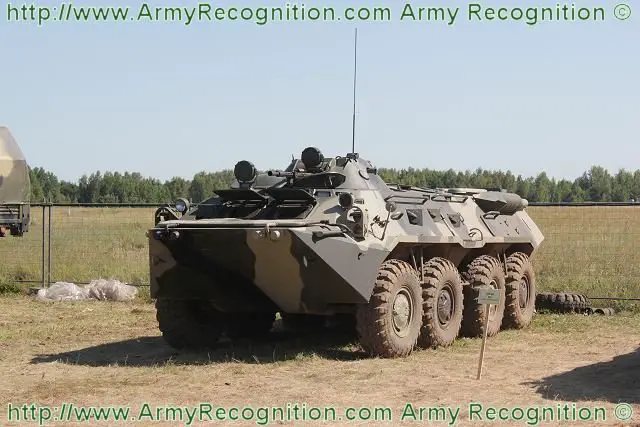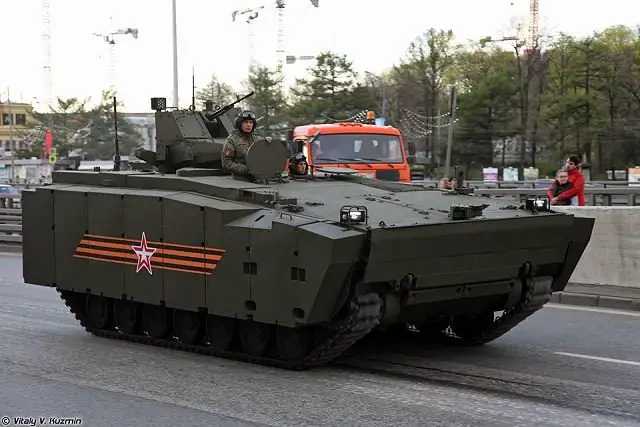|
|
|||
|
Defence & Security News - Russia
|
|||
|
|
|||
| Russian Armed Forces to get new Armoured Personnel Carriers | |||
|
Russian Armed Forces (RAF) urgently need new armoured personnel carriers (APC), according to Russian defense analysts.
|
|||
|
|
|||
|
|
|||
|
Since the end of the Cold War in the early 1990s, Russia`s Land Forces have not changed the military doctrine for the motor rifle troops. They retained two types of organic armoured vehicles, namely, BTR armoured personnel carriers and BMP infantry fighting vehicles (IFV). Hence, RAF had two types of motor rifle battalions, in particular, battalion armed with APCs and the one armed with IFVs. In the late 1980s - early 1990s all ageing armoured vehicles intended for mounted soldiers (such as BTR-60PB/BTR-70 APCs) were phased out. BTR-80 APC and BMP-2 IFV became the organic armour of motor rifle troops.
Both vehicles were developed for traditional war, in which mobility and firepower are the main success factors. Therefore, they lacked ballistic and counter-mine protection. For instance, BTR-80 could resist to 7.62mm steel-core bullet (Level 2 (K) NATO STANAG 4569) and to blast of hand grenades and unexploded artillery fragmenting munitions (Level 1 (M) NATO STANAG 4569). Upgraded BMP-1 (designated as BMP-1P) and BMP-2 have Level 3 (K) (all-round protection against 7.62mm hard steel/tungsten alloy armour-piercing (AP) bullet at 30 m distance) and Level 1 (M) protection in accordance with STANAG 4569 Edition 2. The recent conflict (including the First and the Second Chechen wars) obviously demonstrated insufficiency of BTR-80, BMP-1 and BMP-2 ballistic and especially counter-mine protection. For instance, 12.7mm DShKM heavy machinegun obtained by Chechen rebels could easily pierce BMP-1/BMP-2s sides at 200 m distance, using B-32 steel core AP bullets. Mounted troops did not have anti-blast seats and seatbelt systems to cushion the blast effect. Chechen rebels frequently used Soviet 152mm high-explosive (HE) artillery munitions as improvised explosive devices (IED). For instance, VOF39 HE round contains approximately 7 kg of hexal (Russian designation: A-IX-2, 73% of RDX). It could produce heavy fragmentations, being able to pierce even modern body armour. The explosion of round of such type under belly of BTR-80 or BMP-1/2 guarantees the destruction of the vehicle and casualties among the mounted soldiers and the vehicles crew. |
|||
|
|
|||
 The Russian-made BTR-82A armoured personnel carriers (APC) The Russian-made BTR-82A armoured personnel carriers (APC) |
|||
|
|
|||
|
It should be noted that both BTR-80 and BMP-1/2 are heavily armed. BTR-80 retains 14.5mm KPVT heavy machinegun of BTR-60PB and BTR-70. It could destroy the vehicles armed at Level 1/Level 2 (K) STANAG 4569. BMP-1P is armed with 73mm 2A28 Grom semi-automatic cannon (300mm of rolled homogeneous armour (RHA) AP capability, using PG-9V rocket-propelled grenades) and with one ready-to-launch 9M113 Konkurs (NATO reporting name: AT-5 Spandrel) anti-tank guided missile (ATGM). BMP-2 retains the ATGM and has 2A28 cannon replaced by more effective 30mm 2A42 automatic cannon. As of mid-1990s, BMP-1/2 could destroy all types of Western APCs and IFVs, using the main weapon, while BTR-80 could destroy all types of Western APCs. Moreover, the venerable KPVT machinegun developed in the late 1940s turned to be an extremely effective anti-personnel weapon (especially, using BST bullets).
In the early 1990s Russian Ministry of Defense (MoD) decided to up-gun BTR-80, equipping the vehicle with 30mm 2A72 automatic cannon developed on the base of 2A42. As a result, the enhanced carrier has received new BPPU-1 manned combat module armed with 2A72, 7.62mm PKT machinegun mounted externally in a container on the right side of the module and six 902V Tucha smoke grenade launchers. Hence, BTR-80A`s firepower was brought to the level of modern IFVs. At the same time, the vehicle`s hull was not upgraded and BTR-80A retained low protection level of its predecessor. BTR-80A was popular at the international arms market as it had extremely high cost-effectiveness ratio. A foreign customer had a chance to acquire the firepower of IFV at a price of APC. In the early 2000s, Russian MoD decided to upgrade the armour vehicles of motor rifle troops. The Military Industrial Company (Russian acronym: VPK, Voyenno-Promishlennaya Kompaniya) developed BTR-82A on the base of BTR-80A. BTR-82A is supposed to replace BTR-80. The vehicle`s protection was slightly increased due to the installation of spall liner. BTR-82A retained BTR-80A`s armament set and received modern navigation systems and sights. At the same time, the main disadvantage of BTR-80/BTR-80A (in particular, weak ballistic/counter-mine protection) was not corrected. The MoD also decided to replace BMP-2 by modern BMP-3 to full extent. BMP-3 is modern vehicle, featuring high firepower and Level 4 STANAG 4569 (all-round protection against 14.5mm steel AP bullets at distances up to 200 m) protection, which can be enhanced using applique explosive reactive armour (ERA) plates, bar-slat armour and Arena active protection system (APS). Moreover, Russian defense industry has developed two innovative IFVs, namely, T-15 Armata heavy infantry fighting vehicle (HIFV) by Uralvagonzavod and Kurganets-25 IFV by Kurganmashzavod (a subsidiary of the Tractor Plants concern). Both vehicles are supposed to complement BMP-3s and to replace them in the near future. Moreover, the Tractor Plants concern is continuing to evolve the BMP-3 family of IFVs, having developed Vityaz, Derivatsiya and Dragun vehicles. |
|||
|
|
|||
|
|
|||
|
During the Chechen wars, RAF used MT-LB armoured tracked utility vehicles as personnel carriers. Due to insufficient firepower (in basic configuration MT-LB is armed with one 7.62mm PKT machinegun) and armour protection (Level 1 (K) NATO STANAG 4569), such usage was ceased. Now MT-LBs are exploited only as logistic support vehicles or as high mobility gun tractors. Developed in the early 1970s, MT-LB is also rapidly ageing. Russian Muromteplovoz company is producing enhanced MT-LB variant designated as MT-LBu and offers several options of its firepower upgrade.
It should be noted that Russian MoD also pays attention to the replacement of ageing armoured personnel carriers. As of May 2016, motor rifle troops of RAF retain two types of organic APCs, namely, BTR-80 and BTR-82A. To replace both BMP-1/2 (and BMP-3 in prospect), MT-LBs and (partially) BTR-80, Kurganmashzavod has developed Kurganets-25 unified tracked platform. Kurganets-25 has two configurations, namely, IFV and APC. IFV is armed with 2A42 cannon, four ready-to-launch 9M133 Kornet (AT-14 Spriggan) ATGMs and 7.62mm PKTM machinegun. It is also equipped with APS. APC has received up-armoured 6S21 remote controlled weapon station (RCWS) armed with 12.7mm Kord (RAF designation: 6P49) heavy machinegun. Unlike IFV, Kurganets-25 APC lacks active protection system. The protection level of both vehicles is classified. Russian defense analysts suppose it to be equal to Level 5 STANAG 4569 (all-round protection aga8inst 25mm tungsten alloy armour-piercing fin-stabilized discarding sabot (APSFDS) rounds at distances up to 500 m) or even higher. Russian MoD seems to retain both tracked and wheeled armoured fighting vehicles in its fleet. The Military-Industrial company has developed wheeled 8x8 unified Bumerang platform in two configurations (IFV and APC), which is planned to replace the whole BTR-80 family. The armament kit of Bumerang IFV is the same as the Kurganets-25 IFV`s one. The Bumerang APC has received 6S21 RCWS, like Kurganets-25 APC. Bumerang`s protection level is classified. It is supposed to be Level 4 NATO STANAG 4569 in basic configuration. Hence, Russian Armed Forces seem to upgrade its IFV/APC fleet to full extent. RAF will receive new Bumerang vehicles, as well as Kurganets-25 ones. Such replacement will bring Russian army to the new level. |
|||
|
|
|||
|
© Copyright 2016 TASS. All rights reserved. This material may not be published, broadcast, rewritten or redistributed.
|
|||
















